George Angle
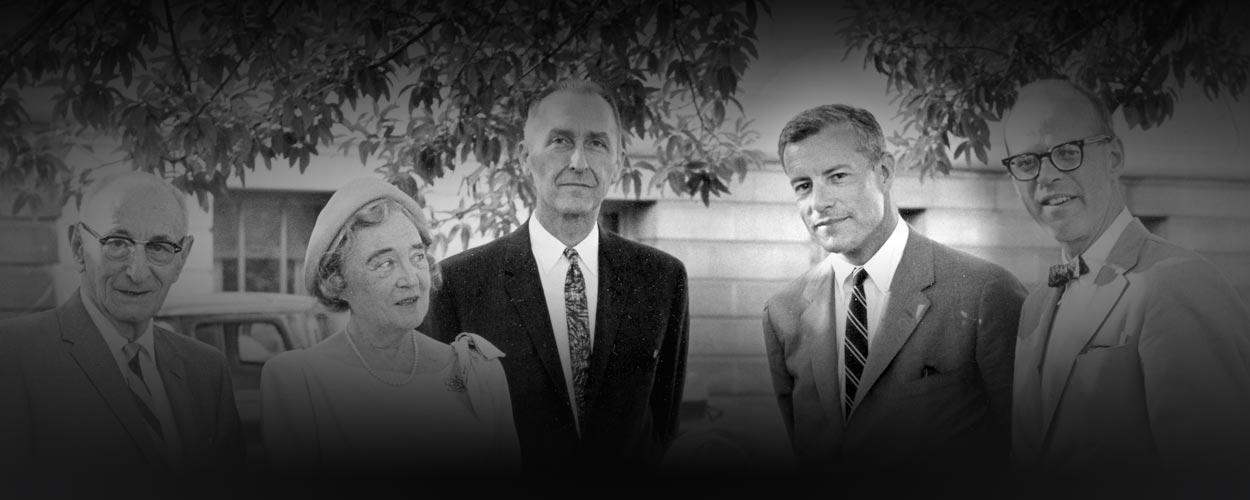
George Angle
George Angle (1922-2016) was a graduate of Harvard College (1943) and Harvard Business School (1948), serving in the U.S. Naval Reserve during World War II.
Hired by the University in 1963 as associate treasurer, he became vice president for business affairs in 1970, and a year later was promoted to vice president for public affairs. In this position, he directed advancement, public relations, and government and community relations. He was named senior vice president in 1987and retired in 1989.
Angle served on the board of managers of the Memorial Art Gallery from 1959 until 1987 and as the board’s president from 1966–68. He served on many MAG board committees, including as chair of the Government Affairs Committee.
Please note:
The views expressed in the recordings and transcripts on this website are those of the speakers, and do not necessarily represent the views of, and should not be attributed to, the University of Rochester.
All rights reserved. Copyright 2019.
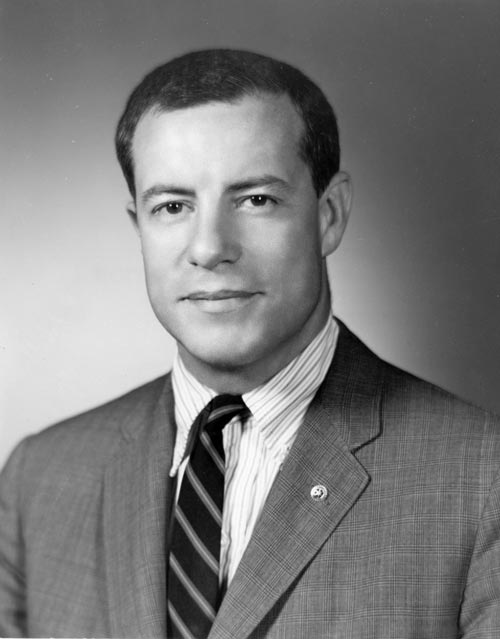
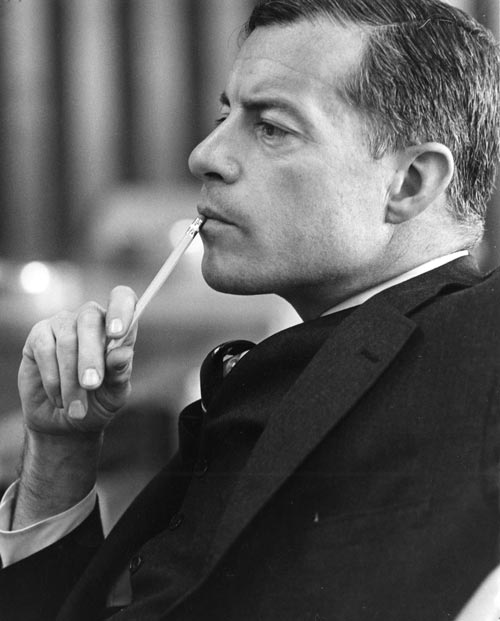
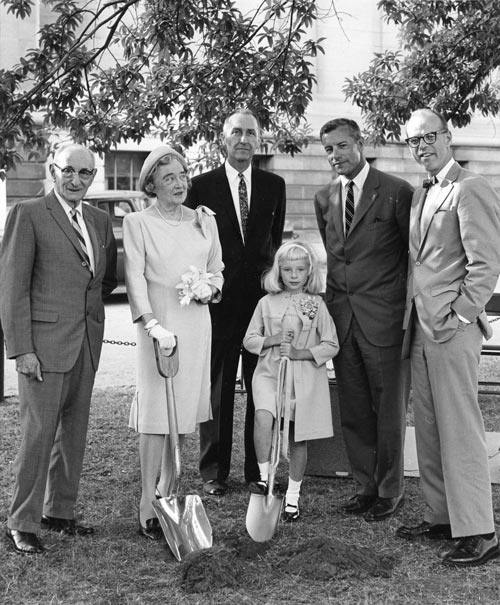
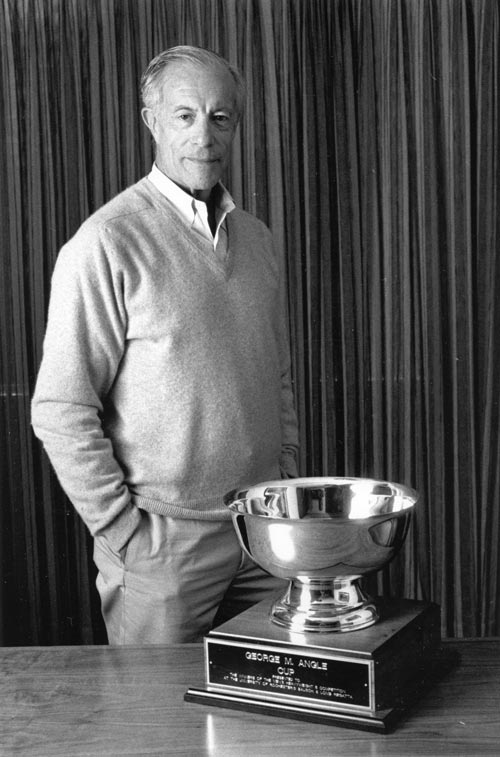
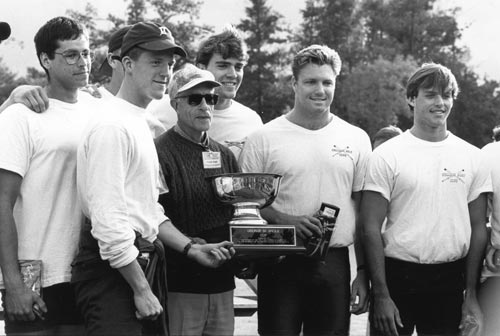
GA: I did know Harris. I always felt I knew him pretty well.
BB: I remember the nice talk you gave at the service.
GA: (...) Yeah, he was a fine person. Very much a professional. Very proud of his profession and determined to function in a professional way. High standards. Very knowledgeable man. It was his business.
BB: And yet it wasn't always his business.
GA: Well, it was always surprising to me and, I think to many people, that Harris had this other side. You know, he was four stripe Navy Captain. They had a problem with the catapults. Apparently, when the jet aircraft came, and they were trying to change from jet, from propeller to jet aircraft, operating from carriers; those jets were bigger and required a higher speed to get them airborne. And they had to shift from the hydraulic catapult to the steam catapult. And they had no problem getting these cars that the planes hooked onto up to the speed, necessarily, the problem was to get those cars stopped. I've forgotten the speed that they would get to. But these, it was the planes would hook on to a car that was propelled forward at high speed by this steam pressure. And then the plane would be released, at or near the end of the track, when they reached flying speed. But then they had to stop the car in a very short space, so it could return and get ready to launch another plane. That was the problem that Harris, got involved in. How to stop that car. I won't get into the detail, but I remember some of it because he told me about it. He was very...here's this guy who's a professional in the history of art. Museology and so on. He had this other side that he was a real expert in mechanisms for launching aircraft.
BB: Fascinating.
GA: But, he was also an effective administrator. He was a good administrator in the sense of being orderly and decisive. But that wasn't the outstanding characteristic. I think the outstanding characteristic as an administrator was the ability to lead people. To inspire loyalty and hard work and dedication. ...certainly would, everybody would agree that during the Harris Prior years, the staff at the Gallery was loyal, and a happy band that enjoyed working there. Enjoyed him, working for him. Liked him, in fact loved him. Fairly decent man. And also, another characteristic of his as an administrator, especially as a administrator of a voluntary organization, which depends so heavily on volunteers, is that he was able to instill in the volunteers a sense that they're really doing something important and they were important people, and that he and everybody else was very grateful to them for the help. So, the volunteer organization, the Women's Council, docents, and the people that worked on the Campaign, and so on, were always, always had high morale. Because of Harris' ability to make them feel good about themselves. ... So that he did combine, I think, quite well the attributes that one would hope to find in a Director of that kind of operation, that is, as a professional, as an art historian, as a good administrator and as a good leader of both staff and volunteers.
BB: I went through the Gallery Notes of that period and, of course, the main thing is the building, and the first reference to it comes in his inaugural speech or what he wrote in the Gallery Notes in October of '62. When he talks about the overcrowded facilities of the old building and the planning that is already going at the new building, and, inroads of time making on the staff, and therefore his regime is going to be one, initially, of evaluation not innovation. Now, my question is, there must have been something going on before Harris came on board. When you looked for a Director, did you, were you looking for somebody that could immediately go into a capital campaign? Was a capital campaign already under way? Do you remember any of that?
GA: It might help me to relate it to the view of the President's at the time. Was Artie Stern the President? He was President, wasn't he, when Harris came?
BB: Could be. January of '63, there was an article on the new wing. Mirage or Miracle in 1963. You along with Tom Hawks and Peter Shedden apparently ran the campaign. Total was $1,139, 437, as I recall was not what the goal was...
GA: No, the campaign, the fundraising--this is not answering your question on when it started(...). I just can't fix that at the moment. But I do know that the fundraising was done in two parts. We, probably that $1,039, 000, may have been the first try...and then we went back, after a little later, and raised some more.
BB: Yeah, yeah, that was like '68 or so? '66? ...in order to add things.
GA: Well, it related to the...
BB: At least I...
GA: Problem with getting the building designed. I can remember this part pretty well. I remember we first selected Gordon Bunshaft of the Skidmore, Owings and Merrill office, and at the time the leader of that was Arthur Stern.
BB: He was the one that...
GA: He was the one that was most influential in selecting Gordon Bunshaft. The reason he selected him had a lot to do with the Bunshaft's successful combination of the new building with a classic building at the Albright-Knox.
BB: Yeah, Bondi [Margaret Bond] says she remembers going on a bus trip to Albright-Knox with a group of patrons. Must have gone up to look at the building.
GA: Well, it's probably true. I don't remember that.
BB: I found a set of those plans.
GA: Okay, well then you know that, they were, Bunshaft designed a building that we then had priced out by, by the Hopeman Contracting Company. I remember the manager was a guy named Charlie Urlaub.
BB: Oh, I just talked to him. He's in a nursing home. On the article I did on building the River Campus.
GA: Is that right?
BB: Because he worked on that.
GA: Well, Hopeman took the plans that, this was the first plan that Bunshaft developed. Priced it out and it came to something like $1.8 million and at that point we had said we have $1.2 million. That's the highest, the most we can go. I think those are about the amounts.
BB: Sounds right.
GA: And, we said we don't have that much money. Please go back and modify the plan to bring the price down where we can afford it. He did. He went back and revised the plan. And then we had it priced again by Hopeman, and it still came out, something like $1.6 million. I can't remember that number. But it was still too high. And it was at that point that the whole thing came to a halt. And we sort of said to ourselves, "What do we do now?" Well, eventually the resolution was to part company with Gordon Bunshaft and the Skidmore office and turn to Carl Kaelber.
BB: Were there any reasons other than the pricing? I've heard that he's a rather difficult man to get along with. He's still living so I probably can't say that.
GA: Bunshaft?
BB: Yeah.
GA: Bunshaft is a, was, is a, I guess a very talented man but he's a very arrogant man.
BB: That's...
GA: He said, I remember one time he said that he didn't mind working with the building committee as long as the chairman of the building committee was an absolute dictator. In other words, he didn't like to work with too many people at all.
BB: Yeah.
GA: (...), but...
BB: Were you on the building committee?
GA: I was. And I may have been the Vice-President at the time because I know I was very closely involved with Arthur. I've forgotten even what years I was President.
BB: Oh, I can check...
GA: You can look that up. But, one of the things that I remember very clearly is that I learned something from all this. And that is that even though we had given the architect a budget, said please design a building that will fit this budget, and when twice he, after twice he had failed to do so, we still owed him $60,000 and had to pay it. That number can be checked. (...). So when we parted company with him...
BB: ...not too happy, I'm sure.
GA: Not too happy about it. Then the second phase was that we got quite a different design from Carl Kaelber and we went back to the second go around on the fund raising. And I think Dr. Watson made another generous gift.
BB: Yes, $240,000.
GA: At that point. Was that the one that was anonymous? And was a challenge.
BB: It's got to be.
GA: I think it was a challenge gift.
BB: It was. I, for some reason somebody told me that that went toward the auditorium. In fact, I think it may...(...)
GA: On that...
BB: There was no auditorium in the Bunshaft plan, there was just a refurbishing of the little theater.
GA: I forgotten that.
BB: But there were other things like a cafeteria and sculpture court.
GA: I kind of forgotten what was in the plan. I remember that in the second go around on the fundraising, Dottie Wadsworth and I were the two principles.
BB: Oh, that's why her daughter is in the picture at the groundbreaking, I suppose.
GA: Probably.
BB: That apparently was quite successful.
GA: Yup. We didn't, we ended up having to borrow, I guess the final cost of the building was in the area of $2.6 million.
BB: Was it really? Because the last figure I had in Gallery Notes was $1.9 million...things keep going up...
GA: But we had to borrow, the Gallery had to borrow from the University. Oh, something in the neighborhood of $400,000, to finish. That building loan...
BB: Is it still going?
GA: No. It was, took quite a few years but it was finally paid off.
BB: Do you remember anything in an anecdotal nature about the groundbreaking? The opening?
GA: I can remember it was outside. You remember; you've probably seen a picture of it. You have a picture of it.
BB: Yeah.
GA: I can remember that it was along the front. The people were seated in front of the new building. The podium was somehow up on the terrace. Does that sound right? From the picture.
BB: It was under the porte cochere.
GA: Really?
{Laughing}
Okay then, I'm on the wrong side of the building.
BB: Yeah. Walter Strakosh, at that point was the President, and he was standing under there. There had been, it had looked like rain all morning. And they couldn't decide whether to have it there or in Cutler. And he was standing under there saying how nice it was that, you know, there was blue sky, and it had cleared up. But he was looking north and the people in the audience were looking south. See this big black cloud coming in and I guess it had to be moved into Cutler.
GA: Maybe I...
GA: Maybe there was difference between...you were talking groundbreaking.
BB: Okay, yeah, this is...
GA: I may have been talking dedication. Which...
BB: No, I'm talking dedication now.
GA: You're talking...
BB: Groundbreaking; I don't know anything. Because I wasn't there. But there is, the picture shows you, Hildegarde Watson--because apparently Dr. Watson wouldn't come--Barbara Wadsworth and Carl Kaelber, and Fritz Trautman representing the artists of the community. Because apparently he'd given a sizeable gift anonymously. $50,000.
GA: That's right. That's...
BB: And I think that was all.
GA: Well, I don't really remember any more.
BB: You had a part in the administration at one point when Harris went on leave February to August of '71. (...)
GA: Well, my role in the administration both at that point and then later when he was sick was, perhaps, less than some people realized. What I would do would be to... I didn't actually function as acting Director. Some people maybe were under that impression. But that wasn't the case in fact. Because what I would do would be to simply, be very much available and then meet with the key members of the staff on a very regular basis, about once a week. It seemed to work since it was a relatively temporary period of time, it seemd to work fine. Of course, those key members were Lang, Bernie, and different curators. Who was the curator?
BB: Uh, Isabel.
GA: Isabel, and then Robert Henning. Did he come, did he succeed Isabel?
BB: He did succeed Isabel and he came beforehand. I mean, Harris hired him.
GA: That's right.
BB: He came shortly before we did the Medieval Faire.
GA: Bob Young, though was in those meetings, and Bondi. And we'd talk over all the plans and problems. All those people were experienced and the Gallery ran very well. And later when Harris got increasingly unable to operate as Director on a full time and vigorous fashion, we carried on that same kind of approach. Although, after Harris got...actually stopped and during the period when we were looking for a new Director, that took quite a while, didn't it? It took a couple years. It was a... between the time when Harris stopped really being the Director, even though, before he died, and the time that John Mahey came on board.
BB: He came in September '76.
GA: That sounds right. Well, you can check with dates.
BB: Yeah, '75, Maxion was the (...). That announcement was made that Prior would retire in June of '76 and the search committee was formed to look for a new Director...
GA: I think Ken Clark was actually the chairman of search committee
BB: Okay, maybe...
GA: Maxion was the President.
BB: President, yeah.
GA: And Bill was President for an unusually long period. At least three years.
BB: Yeah. Because of...
GA: Yeah. The three of us operated as sort of a inner-executive committee, almost. A management committee you might call it. and that was Bill Maxion and Walter Strakosh, and me. But I was the one, that again, had to sort of, could be easily reachable on the other end of the telephone. And a lot of the contacts were with Bernie... The day-to-day operations.
B: Care to say anything about John’s tenure?
GA: I could give my opinion of John as a Director if you wanted me to. Sort of a recent...
BB: Yeah, no, I mean, I guess, actually I interviewed him before he left. It was a very good interview, John (...) the things that had happened...in four years, you can't just leave a hole (...).
GA: I remember that, that was a long search. Not as long as the one for Bret, but it was a difficult search and we interviewed a lot of people.
BB: Was the problem that you couldn't find someone or was the problem that people that you wanted wouldn't come here? Or what? Why was it so hard?
GA: A little of both. For some reason, at that point in time, we seemed to keep running into people that were, sort of, running down our collections. Kept saying the first thing we had to do was to rebuild the scholarship quality of the collection. That the Gallery became, seemed almost like a party line, that the people that we were talking to were talking to each other.
BB: They probably do.
GA: They probably do.
BB: At meetings and...
GA: They probably do.
BB: It’s a small group, isn’t it.
GA: But I remember, myself, when I first met John -- John Mahey -- and spoke, he said, "This is a darn good gallery." And a strong collection sure it, of course could be built up, it's a good collection. It's a good gallery. And he acted like he was really enthusiastic about the...
BB: Yeah.
GA: And that made a strong impression on the search committee...
BB: Backing up a little. Do you remember anything in particular about the search for Harris?
GA: Well, I remember this much, which I guess is not too helpful, and that is that, Arthur Stern and somebody else, might have been Ken Clark. Went to see Harris Prior, who was then President of the...
BB: AFA.
GA: American Federation of the Arts. And the purpose of seeing him was to ask for his ideas and advice on the Director. And it's one of those stories where it wasn't until the end of the meeting that one of them said to him, "Well, would you yourself possibly be interested?" And I guess he...
BB: He said, "I thought you'd never ask."
GA: Yes. I don't think it was that but, he said I might be. He came out, so it went on from there. And what had happened was, that Harris, Harris' personal life...
{Laughing}
....marriage was breaking up and it was time, it was good time in his life to consider a change. So we lucked out on that. I never met that Mrs. Prior at all, but she did come, they were still married when he on the Directorship.
BB: Is that right? Gertrude of course knew her...
GA: I remember that, oh I can remember that Marion Hawks knew her, met her and kind of squired her around when she first came to town. And I don't know that she came (...). Very brief.
BB: Yeah. Well, I guess that's about all... I have all the exhibitions down and we could go over that.
GA: Well, one of the things that just popped into my mind is sort of general observation about the Harris Prior years, and one of the tensions that may exist for any director, but did, it seems to me especially for Harris, was that between the idea of running a, a strictly a scholarly art museum. Which is way over on the side of being only for the serious student. You never degrade the operation of the...
BB: Medieval faires.
GA: Medieval faires, exactly. On the other side was the using the Gallery as a place of fun and frolic and attracting large membership and being very much involved in the life of community, and so on. Plenty of people, and some of them were members of the Fine Arts faculty of the University, were willing to tell Harris that it's a bad thing that he was allowing these fairs and balls and parties and so on, to take place at the Gallery. And this used to bother Harris. And he worried that...
BB: He was very sensitive, wasn't he?
GA: Yeah, he was sensitive. And yet on the other hand, the, the way the Gallery's financed. We raise our money and keep going. You have to do these things. You have to have your Clothesline shows, medieval fairs, Venetian balls, or whatever it might be. And, Harris was, Harris felt that tension. He knew what I'm saying. He agreed with me what I'm saying. But it still, it made him uncomfortable from time to time.
BB: (...).
GA: During his years, I think the membership reached its maximum, reached it's highest point ever. ...9, 8, or 9000.
BB: Yeah. It actually reached that in 1949, too.
GA: It did?
BB: I understand that Gertrude had a different way of counting people, including the fact that she counted staff every day as...
GA: As attending the Gallery?
BB: As attending the Gallery and if they went out for lunch, they would count it twice.
GA: Oh, that helped the attendance.
BB: Apparently, and also counted money as pledged, not after it was actually in pocket. So, it's very hard to compare figures, but it did reach the highest legitimately. In 1949, it supposedly 8,000 and some members belonged and they only raised $11,000.
GA: One of the things that you might, somewhere in there you probably want to say something about the relations with the university.
BB: Yes. That's a good idea.
GA: It's been something I've lived with and observed now for quite a few years.
BB: How long have you been here?
GA: Well, I've been at the university for seventeen years. A little over seventeen years. And I was President of the Gallery just after I came to the university. So, it...
[Tape stops]
GA: …one of the early campaigns. And after I had been his assistant for a couple years, I was the campaign chairman. So, that must have been around '56 or '57. It was probably just after that that I went on the Board. I think '59. I think it's on the sheet with all the...
BB: It is. It is on the sheet. And I'll check it. I would have said it was '57. '59...
GA: In any case, over all that period of years there have been sort of ups and downs in terms of the relationship with the university. But never, no really serious times, there was an episode when some people, it was some kind of long range planning committee chaired by Dottie Wadsworth. Have you found that in the records? And I remember that Charlie Rumrill was on that committee and associated himself with the recommendation that some thought should be given to the idea of the Gallery becoming independent from the university. Nothing ever came of that, but that might have been sort of a low point in the...What?
BB: ...Until Nancy Watson revived the idea.
GA: Oh, that's right. And, actually, Nancy, although she hates the university and espoused the separation, the fact that so many people disagreed with her, that I think it may have had the opposite effect.
BB: Yeah.
GA: People said, "Wait a minute." People like Mims Lawless said that's just wrong.
BB: Yeah.
GA: There’s too much mutually supportive in the relationship to thinking about that idea seriously. But, what I was going to say about it was that it's, a up or down. It has always been sort of an ambivalent kind of relationship at least that, what I always call Go Away Closer, on the one hand the people said the University should take better care of the Gallery. It's their gallery and they should pay more attention to it, give it more money. Repair the roof, whatever. That's the Closer part. The Go Away part is that the university over dominates the Board and runs the Gallery, sort of secretly runs everything. Of course, that has really, that has never been true. It might, I mean, it’s never been true in my time, I can't speak...
BB: Well, I guess Rush Rhees was President of the Board of Managers from 1913 until he retired.
GA: Was he?
BB: He was succeeded by Alan Valentine, so...
GA: Sounds like...
BB: Sounds like...
GA: Things were a little different.
BB: Yeah. It was always that way.
GA: Well, anyway, that's the kind of, I don't know what else there is to say about that relationship. If you have any specific questions that you can think of.
BB: I can't.
GA: I remember the university gave a fairly significant amount of the building fund for the new wing back in the '60's.
BB: Oh, did they?
GA: Yeah, I can't remember the amount. It was something like $280,000.
BB: How do you think the new wing is working out generally speaking?
GA: I think it's worked out extremely well.
BB: I do too.
GA: I understand the shortcomings that are now recognized. Such as having to go through the main concourse, or the exhibition galleries while they're changing exhibitions. I know there's...
BB: Wasn't that area really planned to hang the permanent collection? of American, or 20th century American...?
GA: Was it? I guess you’re right.
BB: Well, I remember it that big gold painting was always there. (...). There were certain things that hung in that room that were simply always there. The Albers and the...
GA: Yes, and weren't some of the Impressionists down there?
BB: Can't remember the Impressionists, but there were things that just didn't get moved.
GA: Yeah. I mean I thought that maybe even 19th century stuff.
BB: So, I wonder if that was actually conceived as a changing exhibition area. Because it seems to me if it was, there would have been a provision made...
GA: Well...
BB: that you could close off.
GA: Yeah, except that on the side of the changing, making it possible to be the changing area was the movable wall.
BB: Yeah.
GA: Approach to it.
[Tape stops]
BB: So, anyway, I don’t know that I have anything else. Who would know at what time the original planning of a new building actually started? Gertrude might, I suppose.
GA: Well, I would think the best way to get at that would be to look at the minutes of the Board meetings. Probably that would...
BB: Ok.
GA: Those things get talked about usually for several years before you get right down to business and...
BB: Look how long the...
GA: Yeah.
BB: This, what's the current status of that? Is Cutler definitely still in the...possibility?
GA: I think Cutler is still a possibility. I think the negotiations among the Eastman School and the university and the Gallery are going along pretty well. Maybe a shared use can work.
BB: Only thing that worries me about that is if the cast of characters changes and...
GA: Right... But I'm sure it would be set up in such a way that (...).
BB: Yeah.
GA: The (...) talks involve Bob Sproull, so, until we got the university administration; senior administration into the act, (...).
BB: Oh, I see.
GA: It didn't work out (...) anyways. satisfactory.
BB: Well, it's a big beautiful building that's going unused. But...
GA: (...).
BB: Whether the spaces fit the Gallery needs...
GA: ... It's going to have to be remodeled. Bret’s got some thoughts on the (...).
BB: Alright, I'll turn it off.

Add new comment